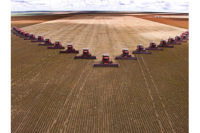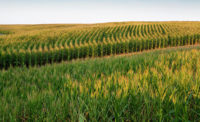Studying commodity pricing and advising executives in the protein industry have become more and more challenging throughout the years. The market is truly global in nature. One hiccup in any major crop producing region of the world can result in a significant market shift.
This year, instability has resulted from the British vote to exit the European Union. There will certainly be winners and losers; however, it’s too early to tell who will fall in each category. The uncertainty continues to makes the market very nervous.
Many European protein producers feed wheat instead of corn because of local supply availability. Instability in this region probably will affect wheat more than corn and soybeans. A key factor to consider is the fact that there are billions of bushels of corn in China that have been poorly stored and have become moldy and unusable. This situation may cause a major purchase by the Chinese.
Demand for soybeans continues to grow around the globe. The increase in soybean acres planted in numerous countries may satisfy the global market despite issues with the crop from Brazil, which had a disappointing yield due to the hot, dry weather.
If traders choose to take a position on corn or soybean futures, it has a dramatic effect on prices. Typically, the futures market takes a position in petroleum at the same time they bet on crops. Because of that, we see increases and decreases in the price of soybean, corn and petroleum travel together in the market. When that market is abandoned temporarily or when traders need to cover margins, the market can see quick declines.
Oil has been in a funk for quite some time. We all know it can’t stay this low forever, but for now it is a fairly moderately priced commodity. Our friends in Saudi Arabia decided not to bail the market out and let it drop to keep Russia, Iran, Venezuela and other rogue nations in check; they may wish they had kept the market at a loftier level.
Looking nationally, independent of oil, we see the following from the U.S. Department of Agriculture report from its June 30 Agriculture report:
- Corn: Corn acreage planted in 2016 was up 7 percent from 2015. Likewise, the area harvested for corn is estimated to be up 7 percent from last year consisting of 86.6 million acres, which would be the third-highest area since 1993.
- Soybeans: With a record high of an estimated 83.7 million acres of soybeans planted in 2016 (up 1 percent from 2015), this crop is predicted to harvest a record high also. Record high planted acreages for soybeans are estimated for Michigan, Minnesota, New York, North Dakota, Ohio, Pennsylvania and Wisconsin.
- Wheat: Unlike the other grains, all wheat acreage is down 7 percent from 2015 with a predicted 50.8 million acres planted in 2016.
Clearly, corn production will be at record levels, much as it was in 2014. With significant carryover from last year, only a major weather event or purchase from the Chinese (none had happened at presstime in mid-July) can prevent a sub-$4 market on corn for protein producers. Because corn is the primary driver of feed ingredients for the U.S. protein industry, this may be a very attractive year for many producers.
While the excess moisture in the Midwest has resulted in the crops being a tad bit behind in schedule, near record yields are still expected. Acreage increases are compounded by significant increases in bushels per acre delivered by improved farming techniques and superior genetics.
We have had good moisture levels up until now. However, if a drought occurs like it did in 2011, we could still have a tighter market. Barring any outside influences, the forecast as it stands now calls for a third year of moderate grain prices. There are never any guarantees until the crop is harvested and sold. NP





Report Abusive Comment